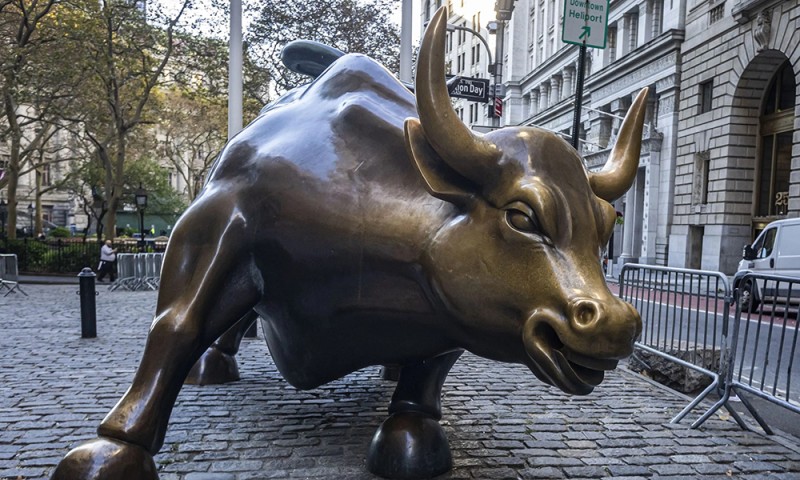
• 摩根士丹利的迈克·威尔逊表示,四月份的股市抛售标志着熊市的结束,新一轮牛市已经开启。他预测称,后续肯定还会出现波动,而且市场可能会在第三季度有所降温。但他又补充道,投资者应继续逢低买入,因为牛市仍处于早期阶段。
虽然市场对美国经济可能走向衰退的担忧不断加剧,但摩根士丹利(Morgan Stanley)的迈克·威尔逊指出,过去三年,美国经济实际上一直处于“滚动式衰退”中。
8月7日,他在接受彭博电视台(Bloomberg TV)采访时表示,现在这场衰退已经结束,四月份那次史诗级的股市抛售(当时特朗普推出的“解放日”关税震惊了投资者)则标志着熊市的终结。
他补充道:“现在我们已经步入新一轮牛市,而资本市场的活跃表现进一步证明了该分析结论的正确性。”
作为摩根士丹利首席美股策略师兼首席投资官,威尔逊表示,在此过程中,出现任何波动与盘整均属正常现象,且相较于2020年那种直线上涨的行情,当前这种渐进式上涨对市场更为健康。
事实上,近期股市已呈现出V型复苏的直线上涨趋势。在四月份低点,标普500指数一度大幅暴跌,较此前高点下跌近20%。自那以后,该指数已飙升30%,且屡创新高,年内涨幅已接近9%。
但威尔逊预测第三季度股市可能会有所放缓,可能会给投资者带来加码押注股市反弹的机会。
“我想非常明确地指出,当前仍处于新一轮牛市的早期阶段,因此大家应该逢低买入,”他说道。
上个月,威尔逊在一份报告中表示,标普500指数到2026年中期可能达到7200点,并解释说,他现在更倾向于认为自己更乐观的“牛市情景”预测会成为现实。
他列举的理由包括盈利强劲、人工智能的应用、美元走弱、特朗普的减税政策、被压抑的需求以及对美联储将于2026年初降息的预期。
威尔逊的观点反映了许多华尔街顶级分析师日益增长的乐观情绪,随着多项贸易协议得到议签署,市场对关税的担忧显著缓解。
上个月,奥本海默公司(Oppenheimer)首席投资策略师约翰·斯托尔茨弗斯、将其对标普500指数今年的目标价从5950点上调至7100点,重新确认了他最初在2024年12月提出的展望。
如果标普500指数今年能上看7100点,则意味着其在2025年的涨幅将达到约21%,连续第三年涨幅超过20%。这种情况自美国经济、股市大繁荣的1990年代末以来还未曾出现过。
与此同时,每逢市场下跌,尽管机构投资者会采取相对谨慎的投资策略,但散户投资者总会不停买入股票,进一步助推市场加速上涨。
逢低买入策略曾带来丰厚回报,但随着越来越多投资者试图抢先布局,反而加快了市场反弹速度,使这种策略的执行难度日益增加。
8月5日在接受美国消费者新闻与商业频道(CNBC)采访时,盈透证券(Interactive Brokers)首席策略师史蒂夫·索斯尼克说:“回调持续的时间(半衰期)正变得越来越短。我认为,大家因为害怕错过回调机会,往往会在回调迹象刚刚出现时就匆忙进场。”
他警告称,不要仅仅因为股价下跌就条件反射式地逢低买入,并称投资者应更审慎,并运用一些分析来寻找真正的价值。
逢低买入的风险在于,有可能“抄底抄在半山腰”,结果买入后股价仍长期下跌。
“市场总能在节骨眼上让最多人集体失策”,索斯尼克说。(*)
译者:梁宇
审校:夏林
• 摩根士丹利的迈克·威尔逊表示,四月份的股市抛售标志着熊市的结束,新一轮牛市已经开启。他预测称,后续肯定还会出现波动,而且市场可能会在第三季度有所降温。但他又补充道,投资者应继续逢低买入,因为牛市仍处于早期阶段。
虽然市场对美国经济可能走向衰退的担忧不断加剧,但摩根士丹利(Morgan Stanley)的迈克·威尔逊指出,过去三年,美国经济实际上一直处于“滚动式衰退”中。
8月7日,他在接受彭博电视台(Bloomberg TV)采访时表示,现在这场衰退已经结束,四月份那次史诗级的股市抛售(当时特朗普推出的“解放日”关税震惊了投资者)则标志着熊市的终结。
他补充道:“现在我们已经步入新一轮牛市,而资本市场的活跃表现进一步证明了该分析结论的正确性。”
作为摩根士丹利首席美股策略师兼首席投资官,威尔逊表示,在此过程中,出现任何波动与盘整均属正常现象,且相较于2020年那种直线上涨的行情,当前这种渐进式上涨对市场更为健康。
事实上,近期股市已呈现出V型复苏的直线上涨趋势。在四月份低点,标普500指数一度大幅暴跌,较此前高点下跌近20%。自那以后,该指数已飙升30%,且屡创新高,年内涨幅已接近9%。
但威尔逊预测第三季度股市可能会有所放缓,可能会给投资者带来加码押注股市反弹的机会。
“我想非常明确地指出,当前仍处于新一轮牛市的早期阶段,因此大家应该逢低买入,”他说道。
上个月,威尔逊在一份报告中表示,标普500指数到2026年中期可能达到7200点,并解释说,他现在更倾向于认为自己更乐观的“牛市情景”预测会成为现实。
他列举的理由包括盈利强劲、人工智能的应用、美元走弱、特朗普的减税政策、被压抑的需求以及对美联储将于2026年初降息的预期。
威尔逊的观点反映了许多华尔街顶级分析师日益增长的乐观情绪,随着多项贸易协议得到议签署,市场对关税的担忧显著缓解。
上个月,奥本海默公司(Oppenheimer)首席投资策略师约翰·斯托尔茨弗斯、将其对标普500指数今年的目标价从5950点上调至7100点,重新确认了他最初在2024年12月提出的展望。
如果标普500指数今年能上看7100点,则意味着其在2025年的涨幅将达到约21%,连续第三年涨幅超过20%。这种情况自美国经济、股市大繁荣的1990年代末以来还未曾出现过。
与此同时,每逢市场下跌,尽管机构投资者会采取相对谨慎的投资策略,但散户投资者总会不停买入股票,进一步助推市场加速上涨。
逢低买入策略曾带来丰厚回报,但随着越来越多投资者试图抢先布局,反而加快了市场反弹速度,使这种策略的执行难度日益增加。
8月5日在接受美国消费者新闻与商业频道(CNBC)采访时,盈透证券(Interactive Brokers)首席策略师史蒂夫·索斯尼克说:“回调持续的时间(半衰期)正变得越来越短。我认为,大家因为害怕错过回调机会,往往会在回调迹象刚刚出现时就匆忙进场。”
他警告称,不要仅仅因为股价下跌就条件反射式地逢低买入,并称投资者应更审慎,并运用一些分析来寻找真正的价值。
逢低买入的风险在于,有可能“抄底抄在半山腰”,结果买入后股价仍长期下跌。
“市场总能在节骨眼上让最多人集体失策”,索斯尼克说。(*)
译者:梁宇
审校:夏林
• The stock market selloff in April marked the end of a bear market, according to Morgan Stanley’s Mike Wilson, who said a new bull market has started. Volatility along the way is normal, and the market will likely cool off in the third quarter, he predicted. But investors should keep buying the dip as the bull market is still in the early stages, he added.
There’s growing concern that the U.S. may be headed for a recession, but Morgan Stanley’s Mike Wilson has said that the economy was actually in a “rolling recession” for the past three years.
It’s over now, and the epic stock market selloff in April, when President Donald Trump shocked investors with his “Liberation Day” tariffs, marked the end of a bear market, he told Bloomberg TV on Thursday.
“Now we’re in a new bull market, and capital markets activity is just another sign that that analysis, or that conclusion, is probably correct,” he added.
Wilson, who is Morgan Stanley’s chief U.S. equity strategist and chief investment officer, said any volatility and consolidation along the way are normal, noting that it’s actually preferable to a market that goes straight up like in 2020.
In fact, the stock market has seen some straight lines lately in form of a V-shaped recovery. At its lows in April, the S&P 500 had tumbled so precipitously and so quickly that it was down nearly 20% from its prior high. Since then, the index has shot up 30%, hitting fresh records and leaving it up almost 9% so far this year.
But Wilson predicted some stock market moderation in the third quarter, potentially offering a chance to double down on the rally.
“I want to be very clear: it’s still early in the new bull market, so you want to be buying these dips,” he said.
Last month, Wilson said in a note that the S&P 500 could reach 7,200 by mid-2026, explaining that he is starting to lean closer to his more optimistic “bull case” scenario.
He cited strong earnings as well as AI adoption, the weak dollar, Trump’s tax cuts, pent-up demand, and expectations for Fed rate cuts in early 2026.
Wilson’s view is part of an increased sense of optimism among other top Wall Street analysts as fears over tariffs ease with the signing of several trade deals.
Last month, Oppenheimer chief investment strategist John Stoltzfus hiked his S&P 500 price target for this year to 7,100 from 5,950, reinstating the outlook he initially made in December 2024.
If the S&P 500 hits 7,100 this year, it would represent a gain of about 21% for 2025, marking a third straight year with a surge of more than 20%. That hasn’t happened since the late 1990s, when the U.S. economy and the stock market boomed.
Meanwhile, retail investors have relentless bought stocks whenever they have dipped, helping turbo-charge the market even as institutional investors have taken a less aggressive stance.
Buying the dip has paid off so well that it’s actually getting harder to do as more investors try to get ahead of the crowd, fueling faster rebounds.
“The half life of dips is getting ever shorter,” Steve Sosnick, chief strategist at Interactive Brokers, told CNBC on Tuesday. “And I think because people are so afraid of missing the dip, they basically rush in at the slightest sign of one.”
He cautioned against reflexively buying dips just because a stock is down, saying investors should instead be more judicious and apply some analysis to find real value.
Still, the risk is that dip-buyers “catch a falling knife” in the process, leaving them with stocks that continue on a long-term decline.
“The market has a way of making the maximum number of people wrong at the most inopportune time,” Sosnick said.

